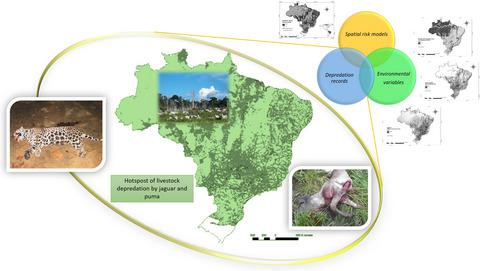当前位置:
X-MOL 学术
›
Anim. Conserv.
›
论文详情
Our official English website, www.x-mol.net, welcomes your
feedback! (Note: you will need to create a separate account there.)
Hotspots of livestock depredation by pumas and jaguars in Brazil: a biome‐scale analysis
Animal Conservation ( IF 2.8 ) Pub Date : 2020-07-13 , DOI: 10.1111/acv.12619 Á. Balbuena‐Serrano 1 , M. M. Zarco‐González 1 , O. Monroy‐Vilchis 1 , R. Morato 2, 3 , R. De Paula 2, 3
Animal Conservation ( IF 2.8 ) Pub Date : 2020-07-13 , DOI: 10.1111/acv.12619 Á. Balbuena‐Serrano 1 , M. M. Zarco‐González 1 , O. Monroy‐Vilchis 1 , R. Morato 2, 3 , R. De Paula 2, 3
Affiliation

|
Retaliatory killing, motivated by depredation of domestic animals by large carnivores, has had a significant impact on wild predators’ populations. In Brazil, pumas and jaguars are the most persecuted species, so it is important to analyse the spatial patterns of depredation risk of livestock. We aimed to identify the hotspots of depredation risk by these two felids in Brazil, as well as the most important variables that determine the risk at the biome scale. We generated spatial models of livestock depredation using a database of depredation records, anthropogenic, topographic and vegetation variables, and ecological niche models. We used six algorithms to generate spatial risk models of depredation and selected those with the best performance, for inclusion in a consensus model, for each biome. Finally, we overlapped the areas of high depredation risk by both felids, so that areas considered as hotspots are those in which there is a high risk that livestock will be preyed by pumas or jaguars. Approximately 17% of the area of the biomes analysed for puma had high depredation risk, and 18% in the case of jaguar. The hotspots encompassed 6.5% of the included biomes’ area. The variables associated with the high depredation risk were different between species and biomes. Depredation risk by pumas was primarily associated with anthropogenic variables, whereas a combination of anthropogenic variables and vegetation types increased depredation risk by jaguar. Biome‐scale analysis, coupled with the availability of reliable data and the implementation of statistically robust methods, provides information specifically on the areas of highest risk and the conditions that contribute to it.
中文翻译:

巴西美洲狮和美洲虎造成的牲畜掠夺热点:生物群落规模分析
由于大型食肉动物对家畜的掠夺,报复性杀害对野生捕食者的种群产生了重大影响。在巴西,美洲狮和美洲虎是受迫害最严重的物种,因此,分析牲畜折旧风险的空间格局非常重要。我们旨在确定巴西这两只猫科动物的掠夺风险热点,以及确定生物群落规模风险的最重要变量。我们使用折旧记录,人为,地形和植被变量以及生态位模型建立了牲畜折旧的空间模型。我们使用六种算法来生成折旧的空间风险模型,并为每个生物群落选择性能最佳的模型,以纳入共识模型。最后,我们重叠了两只猫科动物的高折旧风险地区,因此被认为是热点地区是那些高风险的动物将被美洲狮或美洲虎捕食的地区。分析美洲豹的生物群系区域中约有17%具有较高的掠夺风险,而美洲虎则为18%。热点覆盖了包括的生物群落面积的6.5%。在物种和生物群落之间,与高折旧风险相关的变量是不同的。美洲狮的掠夺风险主要与人为因素有关,而人为变数和植被类型的组合增加了美洲虎的掠夺风险。生物群落规模分析,再加上可靠数据的可用性和统计上可靠的方法的实施,
更新日期:2020-07-13
中文翻译:

巴西美洲狮和美洲虎造成的牲畜掠夺热点:生物群落规模分析
由于大型食肉动物对家畜的掠夺,报复性杀害对野生捕食者的种群产生了重大影响。在巴西,美洲狮和美洲虎是受迫害最严重的物种,因此,分析牲畜折旧风险的空间格局非常重要。我们旨在确定巴西这两只猫科动物的掠夺风险热点,以及确定生物群落规模风险的最重要变量。我们使用折旧记录,人为,地形和植被变量以及生态位模型建立了牲畜折旧的空间模型。我们使用六种算法来生成折旧的空间风险模型,并为每个生物群落选择性能最佳的模型,以纳入共识模型。最后,我们重叠了两只猫科动物的高折旧风险地区,因此被认为是热点地区是那些高风险的动物将被美洲狮或美洲虎捕食的地区。分析美洲豹的生物群系区域中约有17%具有较高的掠夺风险,而美洲虎则为18%。热点覆盖了包括的生物群落面积的6.5%。在物种和生物群落之间,与高折旧风险相关的变量是不同的。美洲狮的掠夺风险主要与人为因素有关,而人为变数和植被类型的组合增加了美洲虎的掠夺风险。生物群落规模分析,再加上可靠数据的可用性和统计上可靠的方法的实施,











































 京公网安备 11010802027423号
京公网安备 11010802027423号